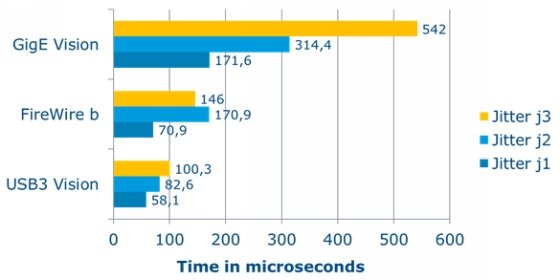When talking about real-time capability there is the absolute latency time and there is a time jitter. The time jitter defines how much the time varies between each cycle. The lower the jitter the better predictable is when the signal will arrive. This really increases the real-time capability. The following graph was measured between 10.000 cycles in a one camera setup. The tested cameras (acA1300-30u (U3V), scA1300-32f (1394-b), acA1300-30g (GigE)) were triggered with a software trigger in a non-overlapping image acquisition mode.
Additionally we divided the measurement into 3 different jitter points:
- j1 defines the mean jitter for executing 10.000 software triggers.
- j2 defines the mean jitter for executing a software trigger and acquiring an image for 10.000 test cycles.
- j3 defines the mean jitter between receiving subsequent images on the PC for 10.000 test cycles.

